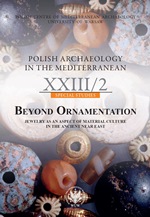Personal display in the southern Levant and the Question of Philistine cultural origins
Personal display in the southern Levant and the Question of Philistine cultural origins
Author(s): Josephine VerduciSubject(s): Archaeology
Published by: Wydawnictwa Uniwersytetu Warszawskiego
Keywords: adornment; early Iron Age; entanglement; embodiment; jewellery; Levant; Philistine
Summary/Abstract: The archaeological artifacts of the Iron Age I–IIA periods found in the southern coastal plain of the Levant (about 1200–900 BC) have certain new features that suggest the appearance of the Philistines or other Sea Peoples. A study of Iron Age jewellery and its stylistic influences sheds light on a period of history that has as yet remained elusive and provides a foundation for constructive discussion of the relations and exchanges affecting the region. Often marginalized as “small finds”, personal adornment is a crucial component in social interaction. The process of adorning the body can convey cultural identity, social status, ethnicity, gender, and age in a manner more immediate than verbal communication. An accurate jewellery typology for the period will assist our understanding of the cultural influences prevalent during the early stages of Philistine society. Using the Philistine Pentapolis sites, and drawing on other sites in the region, both east and west of the Jordan River, the author analyzes methods of cultural display. Using available personal adornment data and focusing on the motifs and technologies occurring in the various assemblages, the author aims is to contribute to the current discourse on cross-cultural exchanges in Philistia in the Early Iron Age.
Journal: Polish Archaeology in the Mediterranean
- Issue Year: 2/2014
- Issue No: XXIII
- Page Range: 247-268
- Page Count: 21
- Language: English

